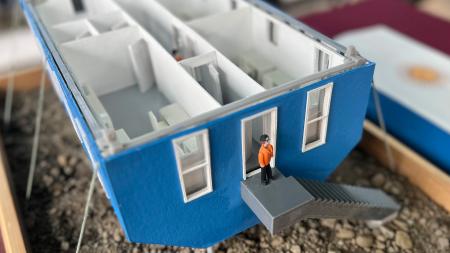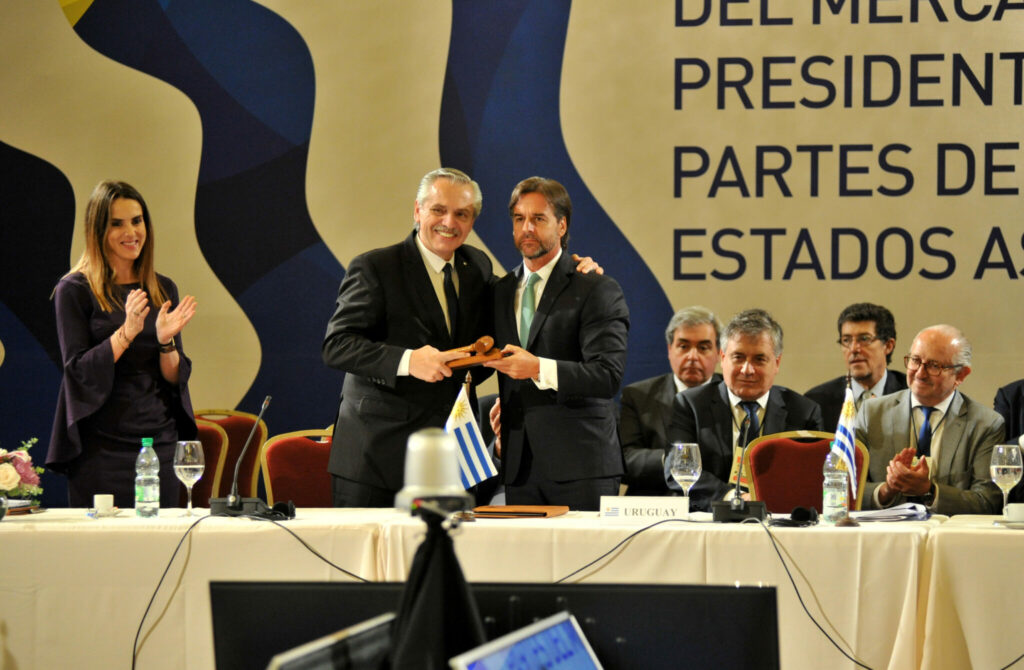The multidisciplinary laboratories and the new shelters that this summer will be set up in the Esperanza, Orcadas and San Martín bases that Argentina operates in its Antarctic territory were presented this Wednesday by the Ministers of Science, Daniel Filmusand Defense, Jorge Taianatogether with the secretary of Malvinas, Antarctica and South Atlantic, Guillermo Carmona.
The new laboratories were designed by Argentine Army engineers to tolerate the most hostile weather conditions recorded in Argentine Antarctic bases, where wind gusts of up to 300 kilometers per hour can be recorded in some of them.
Each building measures about twelve meters long by eight meters widehave an octagonal outer profile to reduce their resistance to Antarctic winds, and are mounted on stilts that separate them one and a half meters from the ground to prevent snow accumulation from affecting the structure.
The laboratories, which will be painted in the colors of the Argentine flag, have separate cabinets for processing wet, dry, and dirty samples, as well as bathrooms and kitchens for researchers; while on the lower level the water, heating and sewer services are installed.

The new buildings are made up of 20 tons of galvanized steel that shape its structure, PIR-type high-density polyurethane panels that are used on its walls, ceilings, and floors, and hermetic double glass openings to maintain thermal insulation; all elements of national production.
In addition, the engineers in charge of the design had to anticipate that all the components of each building could be transported inside commercial containers, which is the way in which they will be shipped on the icebreaker. “Admiral Irízar” and then disembarked at their destination.
The multimodal laboratories were funded with a investment of 260 million pesoss, implemented within the framework of the “Build Science” program of the Ministry of Science with the aim of intensifying scientific research tasks in the Antarctic continent.
“This is a qualitative leap for Science, Argentina is one of the countries that does the most research in Antarctica, and what we are presenting today is possible due to the decision of the Ministry of Science to invest in Antarctic knowledge.”Jorge Taiana
With the same technology developed for the construction of the laboratories at the Esperanza, Orcadas and San Martín bases, shelters are also being built that will also be set up this summer on Isla Vega to facilitate monitoring of glaciers and on Isla Cerro Snowy to increase research capacity on the emperor penguin colonies that live there.
The assembly of the new laboratories, the first unit of which will depart aboard the “Irízar” on December 15, heading to its destination at the Esperanza Base, was carried out at the Center for Maintenance of Facilities and Engineering Team, located in the town Buenos Aires from Villa Martelli, where Taiana, Filmus and Carmona supervised the progress on Wednesday.
The colonel Raphael Guerreroresponsible for the Directorate of Works in Support of National Development, told Télam that “we have been working in Antarctica for a long time, so we are already aware of its conditions and, fundamentally, we work together with the personnel of the Antarctic Joint Command who are the ones who They operate there year-round and know how the building might behave structurally in that particular environment or what the conditions are available for construction.”
“In the design we also involved the Argentine Antarctic Institute because it is the scientists who are going to use these new facilities and we needed to adjust them to their specific needs,” he added.

the lieutenant colonel Federico Devotoin charge of the project, told Télam that “Antarctic climatic conditions impose what is known as ‘resistance design’, another condition to take into account are the logistical possibilities to move all the components there, seeing if it is by plane or by ship and in this case how they are landed, that led us to a design in which all the pieces are joined by bolts and are individualized in such a way that with a simple instruction they can be assembled like a ‘meccano'”.
“A team of twelve people trained in these tasks will accompany each laboratory to complete the assembly this summer, they will also have the support of base personnel”Guerrero completed.
The director of the Argentine Antarctic Institute (IAA), Walter Mac Cormacktold Télam that “this is a milestone in the history of science in Antarctica because it is the construction of laboratories in three bases where there were no these facilities, in some cases some pre-existing structure had been adapted, but there were no conceived, designed constructions and dedicated to science as is going to happen now”.
“Each base is a world apart, but to give the example of the San Martín Base, there were no facilities there to think about long-term projects in geology, biology or oceanography; the laboratory that is going to be set up there this summer opens everything up for us. a vast field of work on a sector for which there is not much scientific information available precisely because of the complexities of going there to do science”, he pointed out.
The researcher added that “in other bases, where perhaps there was a facility that was adapted for science, perhaps there was the possibility of taking samples or making observations, but with the laboratories it will be possible to do the processing there or even much of the analysis of the samples, it is going to be a very big jump in several fields of science”.

The Antarctic Joint Commander, Brigadier General Edgar Calandintold this agency that “These three laboratories are going to be project multipliers and in the case of the San Martín Base laboratory, it is a door that opens for Science towards the deep Antarctic.”
“The two refuges that we are going to install this summer will also be essential on Vega Island for monitoring glaciers and on Cerro Nevado Island for research on the emperor penguin, those who do science in those places will now have more number of work days and more resources to do it,” he pondered.
“Having developed this technology in Argentina and doing it with national suppliers allows us to think that we can modernize our bases with this type of buildings, or even export these constructions to other countries that have already shown their interest,” the military officer completed.
Defense Minister, Jorge TaianaI consider that “This is a qualitative leap for Science, Argentina is one of the countries that researches the most in Antarctica, and what we are presenting today is possible due to the decision of the Ministry of Science to invest in Antarctic knowledge.”

“Not only do we celebrate these three laboratories and the two shelters, here is the development in Argentina of a technology that will allow us to think about the modernization or expansion of our bases, and the collaboration of small and medium-sized industrial companies that are strengthened as suppliers of the project,” he concluded.
The Minister of Science, Daniel Filmus, told Télam that “the government took sovereign policy with respect to Antarctica and the South Atlantic as its central axis, and that there is an enormous development prospect there. Argentina also has a very important scientific vocation in the framework of the Antarctic Treaty, especially in relation to the protection of the environment”.
The secretary of Malvinas, Antarctica and the South Atlantic, Guillermo Carmona, told Télam that “the center of Argentine Antarctic activity is science. Argentina deploys a vast number of research projects every year, and these laboratories come to expand our possibilities and preannounce that we can do the same in other bases with a more ambitious program”.
Also participating in the activity were the head of the Joint Chiefs of Staff of the Armed Forces, Lieutenant General Juan Martín Paleo; the National Director of the Antarctic, Patricia Verónica Ortuzar; and the Undersecretary for Institutional Coordination of the Secretariat for Scientific and Technological Articulation, Pablo Nuñez, among other civil and military authorities.


















